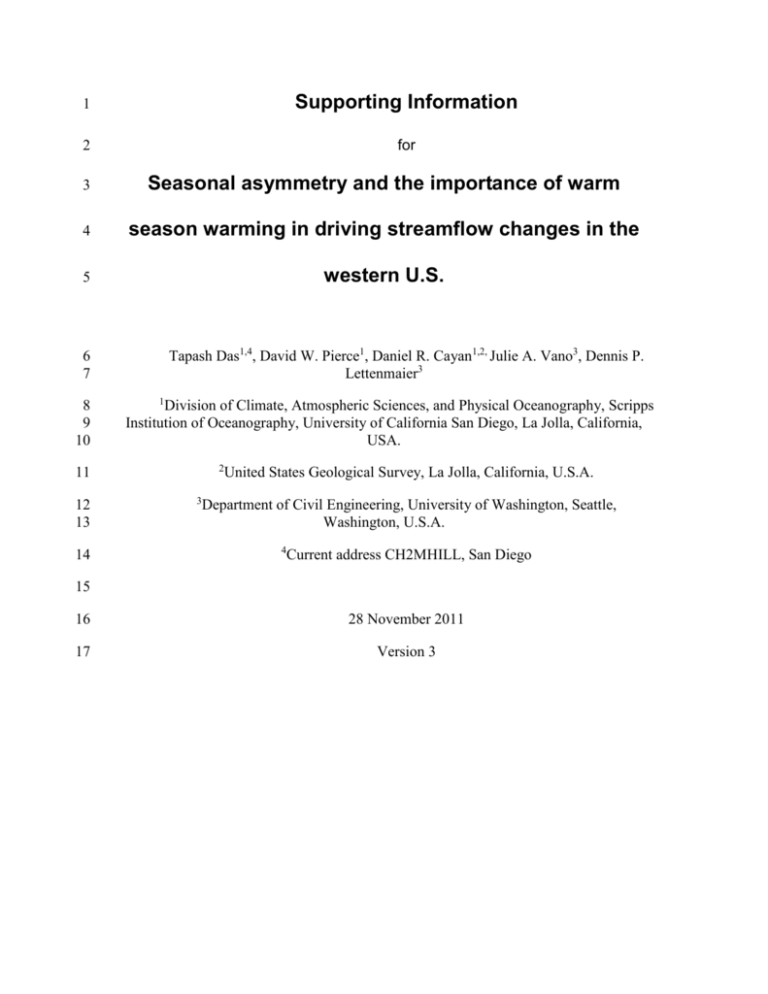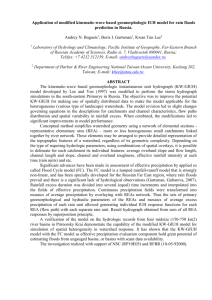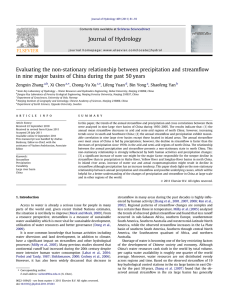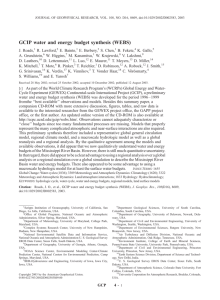grl28673-sup-0002-txts01
advertisement

1 Supporting Information 2 for 3 Seasonal asymmetry and the importance of warm 4 season warming in driving streamflow changes in the 5 western U.S. Tapash Das1,4, David W. Pierce1, Daniel R. Cayan1,2, Julie A. Vano3, Dennis P. Lettenmaier3 6 7 8 9 10 1 Division of Climate, Atmospheric Sciences, and Physical Oceanography, Scripps Institution of Oceanography, University of California San Diego, La Jolla, California, USA. 2 11 12 13 14 3 United States Geological Survey, La Jolla, California, U.S.A. Department of Civil Engineering, University of Washington, Seattle, Washington, U.S.A. 4 Current address CH2MHILL, San Diego 15 16 28 November 2011 17 Version 3 18 19 S1. River basins analyzed The study area consists of the four regionally important river basins shown in Fig. 20 S1. The Colorado River basin consists of the drainage area up to Colorado at Lees Ferry 21 (Arizona). The Columbia River basin considered here consists of the drainage area up to 22 Columbia at The Dalles (Oregon). The northern Sierra Nevada consists of the drainage 23 areas upstream from gauges at the Sacramento River at Bend Bridge, the Feather River at 24 Oroville, and the Yuba River at Smartville. The southern Sierra Nevada consists of the 25 drainage areas from the four main tributaries of the San Joaquin river: the Stanislaus at 26 New Melones Dam, the Tuolumne River at New Don Pedro, the Merced at Lake 27 McClure and the San Joaquin at Millerton Lake. Geographical and climatic conditions of 28 the basins are shown in Table S1. 29 The Colorado River basin receives almost half of its precipitation in the warm 30 season, the highest warm season precipitation fraction of each of the four basins, as 31 shown in Fig. S2. 32 The VIC simulated flow in the basins compares well with that from observations, 33 reproducing the strong seasonality observed in each basin, shown in Fig. S3. Also, the 34 VIC annual runoff efficiency, the ratio of aggregated annual runoff to aggregated annual 35 precipitation in each basin is very close to that from observations (Fig S4). The Colorado 36 River basin converts less than 20% of precipitation into runoff, compared about 40% in 37 the Columbia basin and about50% in the Sierra Nevada basins. Thus, in the Colorado 38 River basin about 80% of total precipitation is lost via evapotranspiration, compared to 39 50% or more in the Columbia and Sierra Nevada, shown by the VIC evaporation 40 efficiency in Fig. S4. 2 41 S2. Meteorological forcing 42 Daily gridded meteorological observations of precipitation, maximum daily 43 temperature (Tmax), minimum temperature (Tmin), and wind speed at 1/8 degree latitude 44 by longitude spatial resolution across the western U.S. were obtained from the Surface 45 Water Modeling Group at the University of Washington 46 [http://www.hydro.washington.edu; see also Hamlet and Lettenmaier, 2005] and cover 47 the period 1915-2003. The data are based on the National Climatic Data Center’s co- 48 operative network of weather observations stations, augmented by information from the 49 higher quality Global Historical Climatology Network (GHCN) stations. The dataset also 50 incorporates information from the monthly PRISM data fields [Daly et al., 1994] to 51 adjust for elevation effects on precipitation and temperature. Such corrections are 52 necessary because topography in the study region affects not only spatial patterns of 53 precipitation (and temperature) but also basin-scale totals of precipitation. 54 55 56 S3. Hydrological model configuration The VIC model is a physically based, semi-distributed model that parameterizes 57 the land surface heterogeneities (in topography, soils, and vegetation) that control the 58 generation of runoff. It includes an energy balance snow accumulation and ablation 59 model [Andreadis et al., 2009], which represents the interactions of snow and vegetation. 60 VIC is configured with three soil layers and 5 elevation bands that are used to account for 61 the effects of sub-gridcell topography. VIC was run with a daily time step in water- 3 62 balance mode, meaning that for purposes of energy computations, the effective surface 63 temperature is assumed to equal the surface air temperature. 64 SI References 65 Andreadis, K, Storck, P, and Lettenmaier D.P. (2009) Modeling snow accumulation and 66 ablation processes in forested environments. Water Resourc. Res. 45, W05429, 67 doi:10.1029/2008WR007042. 68 Daly, C., Neilson, R.P., and Phillips D.L. (1994) A statistical-topographic model for 69 mapping climatological precipitation over mountainous terrain. Journal of 70 Applied Meteorology 33: 140-158. 71 Hamlet, A. F., and Lettenmaier D. P. (2005) Production of temporally consistent gridded 72 precipitation and temperature fields for the continental U.S., J. Hydrometeorol., 6, 73 330–336, doi:10.1175/JHM420.1. 74 4 75 SI Tables Mean elevation (m) Drainage area (km2) Mean Mean annual T (C) annual P (cm) Colorado 2181 283,000 5.3 40 Columbia 1398 615,000 4.1 69 North Sierra 1362 45,800 8.1 90 South Sierra 1843 15,700 6.5 96 76 77 Table S1. Geographical and climatic mean conditions of the basins studied. 5 78 79 Fig. S1 The study area consists of four major river basins in the western U.S.: a) 80 Upper Colorado River measured at Lees Ferry (blue); b) Columbia River measured at 81 The Dalles (white); c) California's Northern Sierra Nevada (purple) measured as the sum 82 of flows of the Sacramento River at Bend Bridge, the Feather River at Oroville, and the 83 Yuba River at Smartville; d) California's Southern Sierra Nevada (red) measured as the 84 sum of flows of the Stanislaus River at New Melones Dam, Merced River at Lake 85 McClure, Tuolumne River at New Don Pedro, and San Joaquin River at Millerton Lake. 86 Colors and contours show elevation (m). 87 88 6 89 90 Fig.S2. Cold season (October through March) and warm season (April through 91 September) precipitation as a percentage of total water year (October through September) 92 precipitation, for our four river basins in the western U.S. 93 7 94 95 Fig.S3. Red: VIC simulated monthly streamflows as driven by observed 96 meteorology from Hamlet and Lettenmaier (2005). Black: Observed (naturalized) 97 streamflows. 8 98 99 Fig. S4. Runoff efficiency, R/P (defined as the ratio of area-averaged VIC 100 simulated streamflows to observed precipitation) and evaporative efficiency, AET/P 101 (defined as the ratio of VIC simulated actual evapotranspiration to observed 102 precipitation) for our four river basins in the western U.S. Solid black color circles show 103 the runoff efficiency computed from observed naturalized streamflows and precipitation. 104 The values are for water year 1916-2002. 105 106 9








